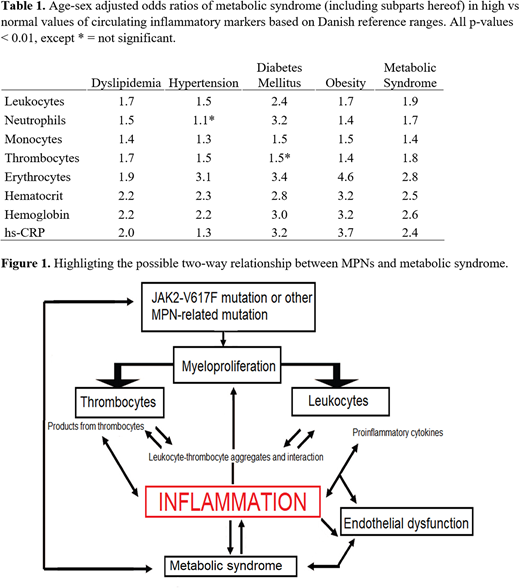Abstract
INTRODUCTION
Chronic inflammation has recently been proposed as the driving force for the development of the Philadelphia chromosome-negative myeloproliferative neoplasms (MPNs). Chronic inflammation is associated with various metabolic disturbances and may also contribute to the massive comorbidity burden in MPNs, which include e.g. inflammatory bowel diseases (Crohn's disease and ulcerative colitis) and polymyalgia rheumatica. Accordingly, MPNs have also been described as "inflammatory diseases". The metabolic syndrome has so far not been shown to be prevalent in patients with MPNs although the chronic inflammatory state might induce insulin resistance as in other chronic inflammatory diseases. If MPNs indeed are preceded by a chronic inflammatory drive eliciting persistent leukocytosis, monocytosis and thrombocytosis, and ultimately clonal myeloproliferation it is intriguing to consider if MPNs and metabolic syndrome share common pathways. If so, an MPN-phenotype might be expected to be associated with metabolic syndrome in the background population. Therefore, in this study, we tested the association between circulating inflammatory markers (CIMs), a phenotypical presentation of MPNs (e.g. erythrocytosis, leukocytosis, and thrombocytosis), and the metabolic syndrome in a general population study.
METHODS
Data sources
In this cross-sectional study, we used data from 20,872 individuals from the Danish General Suburban Population Study (GESUS). Individuals were invited between January 2010 and October 2013 and data were collected through questionnaires, health examinations, and biochemical measurements.
Analyses
We analyzed eight CIMs (leukocytes, neutrophils, monocytes, thrombocytes, erythrocytes, hematocrit, hemoglobin, and high-sensitive CRP) and their linear association with indicators of the metabolic syndrome (according to a modified version of the US National Cholesterol Education Program Adult Treatment Panel III): HbA1c, non-fasting plasma glucose, body mass index, blood pressure, cholesterol, low-density lipoprotein, high-density lipoprotein, and triglycerides. With logistic regression, we calculated odds ratios (ORs) of metabolic syndrome in individuals with increased levels of CIMs compared to individuals with normal levels based on current Danish reference ranges.
RESULTS
In general, there was a positive correlation between most CIMs and indicators of the metabolic syndrome both in the age-sex-adjusted and multivariable linear regression analyses. In the age-sex-adjusted logistic regression analyses, increased levels of all CIMs were associated with increased prevalence of dyslipidemia (OR: 1.4-2.2), hypertension (OR: 1.3-3.1), diabetes mellitus (OR: 1.5-3.4), obesity (1.4-4.6), and the metabolic syndrome (OR: 1.4-2.8). However, neutrophils and thrombocytes were not significant when it came to hypertension and diabetes mellitus, respectively (Table 1).
DISCUSSION & CONCLUSION
In this study we examined the association between different CIMs and a wide variety of metabolic changes. To our knowledge it is the first comprehensive epidemiological study linking the phenotypical presentation of MPNs in a general population of more than 20.000 individuals with a broad spectrum of metabolic disturbances.
With chronic inflammation being proposed as a trigger and consequence of both MPNs and metabolic syndrome and considering the results in the present study it is intriguing to postulate chronic inflammation as the common denominator in both metabolic syndrome leading to MPNs and MPNs leading to metabolic syndrome(Figure 1). It is of great clinical interest to investigate if an increased risk of metabolic syndrome exists in e.g. a cohort of MPN patients and whether people with incident metabolic syndrome have increased risk of MPNs and second cancer.
An increased prevalence of a wide variety of metabolic disturbances following increased CIMs could potentially, if similar results are found in the MPN population, support a future change in the MPN-risk stratification. Amongst the tested CIMs only thrombocytes (> 1500 Mia/L) are currently used as a risk factor.
In conclusion, elevated levels of CIMs were associated with an increased prevalence of metabolic disturbances. Our results substantiate the need for similar studies in MPN patients, being characterized by chronic inflammation and elevated cell counts.
Hasselbalch:Novartis: Research Funding.
Author notes
Asterisk with author names denotes non-ASH members.


